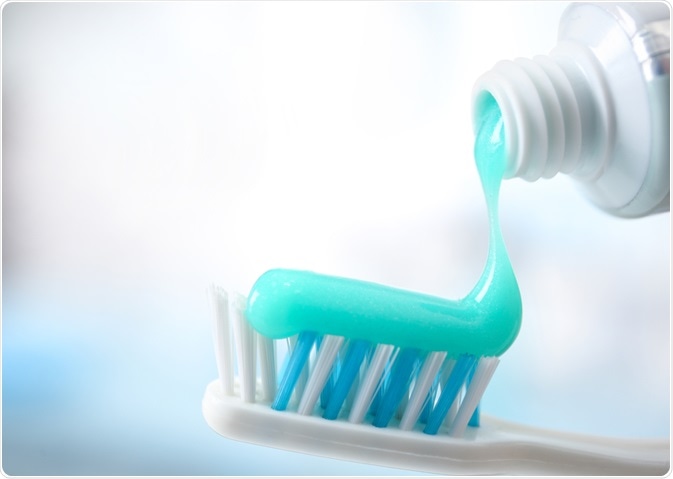Is Fluoride Good or Bad for Teeth?
Fluoride is a naturally occurring mineral which is helpful in protecting against dental cavities. However, the excessive consumption of fluoride can have deleterious effects on teeth and overall human health.
 Africa Studio | Shutterstock
Africa Studio | Shutterstock
What are the major sources of fluoride?
Fluoride is added to tap water in many countries and can also be found in several naturally occurring foods. A fluoride concentration of 0.7 to 1.2 ppm (parts per million) is considered to be most beneficial for body and teeth. The various sources of fluoride are described below:
Tap water
Though fluoride is found naturally in fresh water, it is also added to the tap water supplies in many countries. The amount added depends upon the concentration of fluoride occurring naturally.
Fluoride toothpaste
All toothpastes approved by the American Dental Association (ADA) contain fluoride. Such toothpastes can be used to provide additional protection against cavities. The amount of fluoride added to toothpaste is enough to provide an additional protection to teeth besides that added into the community water supply.
ADA guidelines for the use of fluoride toothpaste vary. Children below three years of age should use toothpastes with a fluoride level of 1000ppm whereas children above three years of age can use toothpaste containing 1350 ppm to 1500 ppm fluoride.
Toothpastes should never be used in used in excessive amounts to avoid the various side effects of fluoride poisoning. Only a pea-sized amount of toothpaste should be used by children below seven years of age.
It is advisable to spit out the mouth contents after brushing rather than rinsing the mouth with water. This is so that the fluoride present in the toothpaste can remain in contact with the tooth surfaces for a longer period.
Why do we need to add fluoride to tap water and toothpaste?
Children in poor socio-economic conditions are more prone to develop cavities, primarily due to the limited availability of fluoride in the water supply. Such children are five times more likely to develop tooth decay. The addition of fluoride to the water supply is one way to protect underprivileged children from cavities.
Some individuals are more susceptible to cavities. In such cases, fluoride is applied by the dental care professional directly to the tooth surface to prevent cavities. Fluoride varnishes or gels are also available for self-application. Individuals with salivary flow have an increased risk of cavities, and fluoride application may help prevent this condition in such cases.
How does fluoride prevent cavities?
Dental plaque on the tooth surface contains a wide variety of cariogenic (cavity-causing) bacteria, which enhance the process of tooth loss and demineralization. These bacteria inhibit reparative processes within teeth, leading to tooth decay and cavities.
Fluoride has both preventive and therapeutic effects against dental cavities. When consumed in appropriate amounts, this mineral accelerates the process of remineralization and hampers demineralization.
Cariogenic bacteria metabolize carbohydrates and release acids. As the pH of the mouth goes down, fluoride is liberated from plaque and adheres to the calcium and phosphate released from the demineralized tooth surface. This ultimately forms a superior enamel crystal structure. This newly formed enamel structure is more resistant to acids, and is high in fluoride concentration and low in carbonate content.
Some clinical studies have also demonstrated that when fluoride is persistently present at low concentrations in the oral cavity, it has the property to inhibit the action of cariogenic bacteria like Streptococcus mutans by reducing their acid production.
What are the adverse effects of fluoride on dental health?
Some areas have a naturally high concentration of fluoride in the water supply. Excessive levels of fluoride lead to dental fluorosis. Fluorosis results in the appearance of white chalky spots on the tooth surface because of hypomineralization. This results in enamel opacities and the teeth appear aesthetically unpleasant.
Fluorosis occurs when children consume high amounts of fluoride especially at the stage of tooth development. However, the intensity of this condition depends on the dose, duration, and timing of fluoride consumption. For instance, with the front teeth of the upper jaw, the most critical period is around the age of 15 to 24 months for boys and 21 to 30 months for girls.
While examining the reason for "mottled enamel”, better called moderate to severe enamel fluorosis, it was found that available fluoride in the drinking water supply had an anti-cavity effect on the teeth. However, too high fluoride content was associated with enamel fluorosis.
Sources
- https://www.cdc.gov/mmwr/preview/mmwrhtml/rr5014a1.htm
- https://www.ncbi.nlm.nih.gov/pubmed/2129630
- https://health.gov/environment/ReviewofFluoride/exec.htm
- https://ilikemyteeth.org/fluoridation/fluoride-myths-facts/
- https://www.dentalhealth.org/fluoride
- https://www.ncbi.nlm.nih.gov/pmc/articles/PMC4733546/
Further Reading
- All Dentistry Content
- Dental Crown / Tooth Cap
- Radicular Cysts
- Tartar Causes
- Importance of Pharmacology in Dentistry
Last Updated: Jan 11, 2019

Written by
Akshima Sahi
Akshima is a registered dentist and seasoned medical writer from Dharamshala, India. Akshima is actively involved in educating people about the importance of good dental health. She examines patients and lends free counseling sessions. Taking her passion for medical writing ahead, her aim is to educate the masses about the value of good oral health.
Source: Read Full Article
